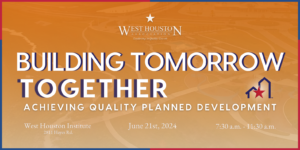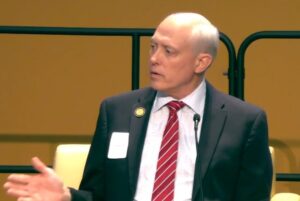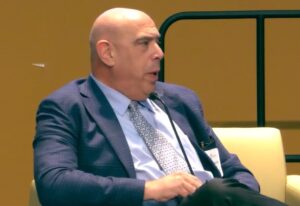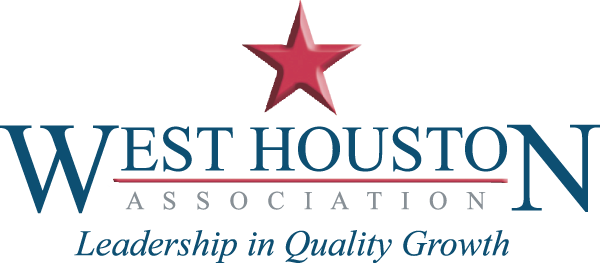
This is the third in a three-part series to summarize takeaways from the West Houston Association’s Quality Planned Development symposium entitled “Building Tomorrow Together” that took place on June 21, 2024.
The “Tapped In” panel explored funding for water infrastructure projects, discussed public-private sectors collaboration, and provided crucial insights into addressing Texas’ growing needs amidst population growth and aging infrastructure challenges. Led by Alia Vinson, WHA Board Member and Partner at ABHR, the discussion featured Scott Galloway, Outreach Specialist with the Texas Water Development Board (TWDB) and Richard Seline from the Resilience Innovation Hub.
 Scott Galloway highlighted TWDB’s pivotal role in Texas, serving as both water resource planners and financiers. “We do two things really. We are water resource planners and then we function like a bank.”
Scott Galloway highlighted TWDB’s pivotal role in Texas, serving as both water resource planners and financiers. “We do two things really. We are water resource planners and then we function like a bank.”
He emphasized TWDB’s administration of federal and state-funded programs, including low-interest loans and grants for water projects. Galloway stressed the importance of these funds in supporting diverse communities across Texas, from rural to economically disadvantaged areas. Challenges highlighted included meeting high demand with limited funding, especially for operational costs.
Richard Seline brought a focus on innovative funding models and risk mitigation strategies. He advocated for predictive modeling to address escalating natural disaster risks and emphasized the potential of public-private partnerships (PPPs) in funding resilient infrastructure. Seline stressed the need to use predictive modeling and forecasting of future conditions rather than relying on historical antidotal data when doing cost/benefit analysis. He provided an example, “If I go in and retrofit homes that are constantly flooded, it is not just fixing the sticks and bricks, but if I change the materials in it, I can substantially reduce the mold content.” This allows for calculation of benefits beyond the economics of the flood, but also the health/safety risks that would impact the health insurance business. This is a model quite different from what is used today by groups like the US Army Corps of Engineers and could change how we think about cost/benefit ratios.
 Seline also highlighted successful examples like Babcock Ranch, where proactive private investments resulted in minimal hurricane damage and enhanced community resilience. “It was designed, built, delivered, and operated for the purpose of withstanding a direct hit of a hurricane. When Hurricane Ian hit Florida last year it went right over Babcock Ranch. Everything else was destroyed. Babcock Ranch only lost a few trees, a few tiles. They never lost power. They never lost water. They never flooded. It was purposely designed as a mixed-use development by a developer who said, ‘I am going to incur the 30-35% more cost to do this the right way.’”
Seline also highlighted successful examples like Babcock Ranch, where proactive private investments resulted in minimal hurricane damage and enhanced community resilience. “It was designed, built, delivered, and operated for the purpose of withstanding a direct hit of a hurricane. When Hurricane Ian hit Florida last year it went right over Babcock Ranch. Everything else was destroyed. Babcock Ranch only lost a few trees, a few tiles. They never lost power. They never lost water. They never flooded. It was purposely designed as a mixed-use development by a developer who said, ‘I am going to incur the 30-35% more cost to do this the right way.’”
Both panelists discussed challenges in funding, particularly for rural and economically disadvantaged areas.
Galloway acknowledged efforts to revitalize funding programs like the Texas Rural Water Assistance Fund, aimed at alleviating financial barriers in these communities, emphasizing that there have been active programs that lacked appropriation until recently. “It was basically an active fund with a zero cash balance in it. … Texas voters approved $1 billion back in November of this last year. There is new funding for the Texas Rural Water Assistance Program.”
Seline emphasized the need for innovative financing mechanisms like Resilient Utility Districts (RUDs) to attract diverse capital sources and supplement public funding requirements. RUDs “incorporate not just water and power but everything that you can do to help a developer buy down the cost of creating a resilient community. It might be 30 to 35% more expensive, but it also can attract additional capital, both public and private, and even philanthropic money that is currently not being tapped into.” His perspective underscored the need for integrating economic incentives with long-term resilience goals.
 The panel concluded with recommendations for enhancing community engagement and funding accessibility. Galloway encouraged stakeholders to participate actively in regional planning and legislative sessions to align infrastructure needs with TWDB funding priorities. Seline emphasized collaboration among stakeholders, such as a public private philanthropic partnership type of round table and leveraging data-driven approaches to attract private sector investments in resilient infrastructure.
The panel concluded with recommendations for enhancing community engagement and funding accessibility. Galloway encouraged stakeholders to participate actively in regional planning and legislative sessions to align infrastructure needs with TWDB funding priorities. Seline emphasized collaboration among stakeholders, such as a public private philanthropic partnership type of round table and leveraging data-driven approaches to attract private sector investments in resilient infrastructure.
The panel discussions provided a comprehensive overview of the challenges and opportunities in funding water infrastructure projects in Texas. Insights from TWDB and the Resilience Innovation Hub underscored the importance of innovative financing models, proactive risk mitigation strategies, and collaborative partnerships to address growing infrastructure demands and enhance community resilience. Future efforts will likely focus on expanding funding accessibility, fostering stakeholder engagement, and integrating resilient solutions to safeguard Texas communities against future challenges.
